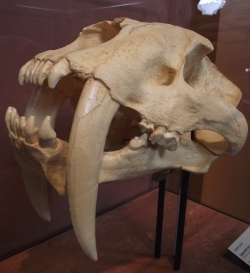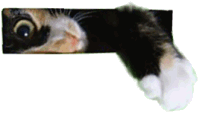The Smile of the Smilodon - Sabre-toothed cats de-mystified

Fans of the animated movie Ice Age shivered as Soto the evil sabre-toothed tiger planned to rip his human prey to shreds with his elongated fangs. But how accurate is this image? Did sabre-toothed cats ever actually hunt homo sapiens, and if not homo sapiens, how about Neanderthals? The image of the sabre-toothed cat as the ultimate hunter exists in numerous books and films, and even on the jerseys of an American NHL ice hockey team. (The Nashville Predators.) So how does this image stack up to reality?
We can say with certainty that sabre-toothed tigers did not hunt Neanderthals. First of all, sabre-toothed cats weren't tigers, or even close relatives. That honour goes to the modern North American wildcats, such as the puma and bobcat. And like the puma and bobcat, the sabre-tooth is an American. Neanderthals lived in Europe, so even if sabre-toothed cats were tigers - which they weren't - intercontinental distances took Neanderthals off the menu.
The Atlantic ocean was certainly between Europe and America in the time of the sabre-toothed cats. In fact the world was pretty much the same as today, for the last of the sabre-tooths died out around 8000 BC, and geological forces have not greatly re-shaped the planet since then.
Fangs for the memory
The sabre-tooth species lived through most of the Pleistocene epoch - that's the period that started 2.5 million years ago and ended when the earth started to warm up at the end of the last ice age 10,000 years ago. (That ice age is still ending, though it may now be doing so somewhat faster than scheduled.) The sabre-tooth cat's distinctive dental arrangements were shared to a lesser degree by others in the same family of 'fighting teeth' (Machairodontae), and particularly by the contemporaneous Homotherium. In fact because they are useful for biting and holding, large canines have been developed by several other species in what biologists call 'convergent evolution'. These species include vampires and Scrat, the sabre-toothed squirrel who starts the movie Ice Age. However no animal has ever developed canines to the degree of the sabre-tooth, or Smilodon, which means 'knife tooth' in Greek.
The latest and greatest of the Smilodons was Smilodon populator, a monster cat bigger than any other ever on the earth apart from the liger. (See here for ligers). Populator sported fangs that more than matched his massive body - canines that protruded up to twenty centimeters (7.8in) from its upper jaw. As might be expected, such a jaw required formidable muscular evolution before it could even open wide enough for the teeth to produce a proper bite. Rather as does a modern domestic cat, the Smilodon produced that bite by twisting its head downward and forward. However, the bite itself was something of an anti-climax - it had less than half the pressure that a modern tiger can produce.
Furthermore, those impressive fangs were incapable of rending prey, because the Smilodon's massive canines were also knife-like in that they were oval in cross-section and relatively thin for their length. If the cat sank those fangs into a vigorously struggling animal, there was a good chance that they would snap. In fact a recent discovery suggests this is what happened to the Smilodon who left parts of his shattered teeth in the skeleton of a dire wolf. The wolf probably attracted the Smilodon's ire by jumping the queue for dining on a carcass. There would usually be a lot of scavengers hanging around after a sabre-tooth's kill as it is generally assumed that Smilodons were what is called 'wasteful predators'. Their huge teeth were not good at chewing anything smaller than large steaks, and very poor at cracking bone - that poor pressure and fragility once more - so there was plenty of meat left when the sabre-tooth was finished.
In fact the evolutionary advantage of the Smilodon lay less with its distinctive teeth than with its immensely muscular forelegs - which were considerably more powerful than those of any cat alive today. These forearms make the Smilodon the Popeye of the cat world, and were so long and strong that a mature Populator stood 1.22 meters (four feet) high at the shoulder, and from there the spine sloped back toward shorter hind legs, rather as does that of the modern hyaena.
Hunting techniques
The Smilodon had a bob tail, which tells biologists that it did not need a tail to balance while running, as do modern cheetahs, for instance. Therefore it has been concluded that the Smilodon was an ambush predator, rather like a modern domestic moggy on super-steriods. (This incidentally is why putting a bell on your cat does not stop her massacring birds - an ambush predator, be it domestic or Smilodon, lurks under cover until prey come within range and then is captured in a short, sharp rush. During that rush the prey may be well aware - bell or no bell - that there's a hungry cat coming. It's just too late to do anything about it.)
Once Smilodon had got to grips with its prey, teeth and muscular forearms worked in harmony. Those massive forearms would wrestle the victim to the ground where windpipe and arteries were exposed to canines perfectly designed to rip them open. Dracula had nothing on this. A single slash of those massive teeth took the flesh off almost everything in the throat area back to the spine. Then it is probable that the Smilodon simply walked away. All it had to do was wait while its victim expired from suffocation and massive blood loss, and then the killer came back to dine. To help in delivering that one all-important bite, Smilodon had a neck which was both longer and stronger than that of any modern cat species. The throat bones of the sabre-tooth also tell us that Smilodon could produce a truly terrifying roar.
There are also suggestions that the sabre-tooth did not work alone, so victims did not have to merely fight off one cat, but an entire pack. Bones have been found which show that Smilodon prey did not always go quietly. Smilodons risked getting bitten, gored, kicked and trampled during a hunt. Bones have been found with injuries from all of these, but in some cases the cat has made a good recovery from what should have been a crippling injury. Since a lone predator would have starved to death before it recovered it is probable that wounded Smilodons had help from others - presumably pack members. Sabre-tooth-shaped holes turn up occasionally in Smilodon bones, so it seems that domestic life in the pack could get fractious.
The sabre-tooth was spread across the Americas. From where bones have been found, we know that the creature liked open woodland and pine forest. Prey was almost any animal large enough to provide a good meal, and the menu of the American Pleistocene included camels, the massive and now extinct ground sloth, bison, horses and even young mammoth and mastodons. Also, the last of the sabre-tooths might have sampled a small but succulent species of biped which had crossed the land bridge from Eurasia as the glaciers retreated - homo sapiens.
The Smilodon family
The first of the sabre-tooths was a relatively small 50-100kg (120-220lbs) called Simolodon gracilis. This was evidently a successful predator, for it both grew and evolved as the species spread across the Americas.
By the time the sabre-tooths had reached South America gracilis was on the way out, largely replaced by the altogether more chunky and appropriately-named Smilodon fatalis. This creature was about the size of a modern Siberian tiger - that is, about a metre high at the shoulder and around 220kg (485 pounds) in weight.
Populator, the final version, went in for size, muscle and of course, teeth. It was not only longer and taller than its predecessors but much more muscular, probably topping the scales at around 470 kg (1000 lbs); which makes it among the heaviest known cats ever. This was a highly specialized predator (a 'hyper-carnivore' in technical language) which was highly evolved for the conditions in which it lived.
The End of the Sabre-toothed cats
This environment-specific evolution was probably the Smilodon's downfall. The climate of north America was not (and is not) static. As the ice age ended, the forests of the Smilodon's natural habitat gave way to open grasslands less suited to ambush techniques.
At the same time, other species were getting quicker and adapting faster. The new kids on the block, the human race, proved adept at competing with sabre-tooths for slower, meaty prey such as ground sloths which were also headed for extinction. This may be why evidence shows that some later Smilodons tried chewing through bones, ill-adapted for this as their teeth were. This is something that did not happen when food was more abundant. In short, as the world changed around them, the Smilodons were trapped in an evolutionary dead end, and died out because of it. They were adapted for a time that had passed, and their species had simply become, well, too long in the tooth.
Appendix 1 Smilodons v. Lions
The African lion is a useful comparison to the Smilodon. Both are large predatory cats which live in groups. However, unlike the sabre-tooth, the lion has very successfully adapted to hunting in grasslands, possibly because savannah offers more ground cover than prairie.
As far as can be determined, Smilodons were like most cats in that they had limited sexual dimorphism. Sexual dimorphism means that the genders have different shapes, and a Miss Universe does not look like Arnold Schwartzenegger. Lionesses lack the male's distinctive mane, and are somewhat smaller. Smilodons, like domestic cats, were about the same size in both genders, and there are no features which make it immediately obvious whether the sabre-tooth bones belong to one gender or the other.
Lion canines are at most two inches long - smaller than even a tiger's, and as a result a lion needs only open its mouth 60 degrees to deliver a bite. The huge canines of the sabre-tooth needed the jaw open to a gaping 120 degrees to get the teeth clear of each other. Yet a lion can exert over 300 kg (700 lbs) of pressure with its bite, whereas the Smilodon could manage only 100 kg or so.
Though lions and sabre-toothed cats were about the same length, the Smilodon packed so much muscle on its frame that it weighed about twice as much. This was a huge advantage to the sabre-tooth when prey was large and powerful, but a fatal flaw when prey became fast-moving and agile.
Appendix 2 The La Brea Tar pits
These tar pits are a fascinating relic of an earlier epoch now situated in the heart of modern Los Angeles. Tar (brea in Spanish) is forced up from the ground here by natural pressure and forms pools which are often covered by water. Over millennia animals coming to drink from this water have become trapped in the tar beneath.
An unusual feature of a tar pit is that it is a natural predator trap. If a herbivore is trapped in the tar it gives cries of distress. These cries both warn off fellow herbivores and attract predators. The predators become trapped in turn, and thousands have left their bones in the tar pits where the heavy oil has preserved them until the present day.

A Smilodon fatalis skull from the San Diego Natural History Museum, California, USA. 1905 painting by Charles R. Knight in the American Museum of Natural History in New York City.

